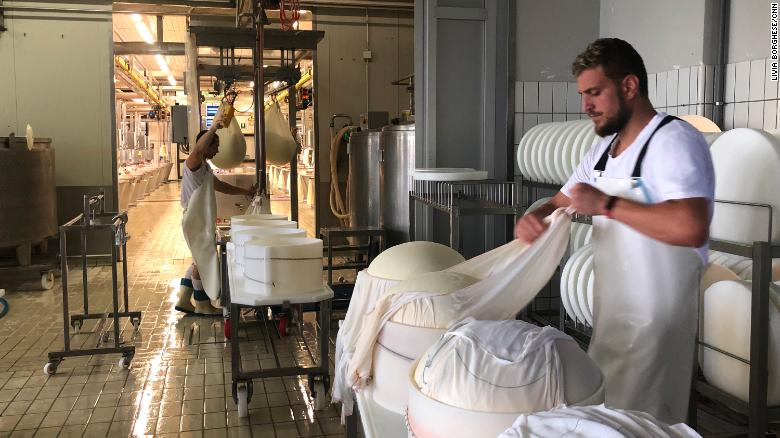Lake in Chile is about to dry up completely 2:24
On the Po River, Italy (CNN) --
The main artery through the heart of Italy, where 30% of its food is produced, is the 650-kilometer-long Po River, which meanders from the Alps to the sea. Adriatic on the northeast coast of Italy.
But a dry winter and spring mean this year is in trouble.
The "Great River", as it is known, plays a fundamental role in the country's history.
Before bridges were built, its deep waters protected civilizations on both sides from invaders who couldn't cross.
In later years, cities and industries sprang up on its banks, harnessing the water for hydroelectric power, transportation, and irrigation.
Along some stretches of the Po River, processing plants transform river mud into drinking water.
5 places that emerged due to droughts: how extreme weather reveals vestiges of past lives
The Po is fed by winter snow from the Alps and by heavy spring rains, which often cause devastating floods.
In a cafe located on the banks of the river, near the city of Mantova, a measuring stick on the wall indicates the height of the water.
In 1951, it almost hit the ceiling.
But in 2022, things are very different.
An unusually dry winter meant little snow melt and sporadic spring rains, leading to the worst drought in northern Italy in more than 70 years, a regional Po River agency confirmed.
advertising
The sandy bed of the Po River can be seen near Mantua.
As a result, the Po is reaching minimum water levels, according to the European Space Agency.
An animation from the agency's Copernicus Sentinel-2 satellite mission reveals how the river has "reduced significantly" between June 2020 and June 2022.
And that's a big problem for the millions of people who depend on the Po for their livelihood.
Salinization from the Adriatic Sea has begun to turn its fresh water into an unusable poison for crops.
Recent analyzes show salt water more than 20 kilometers (12 miles) inland, and as the river recedes, the sea will continue to fill the void.
Massimiliano Fazzini, head of the Department of Climatic Risks of the Italian Society of Environmental Geology, affirms that in the current hydrological year, which began on December 1, the Po basin has a water deficit of between 45% and 70%. in some areas.
"Normally I'm never pessimistic or alarmist, but this time you have to be," he told CNN, citing the difference in average snowfall, which has gone from 7.5 meters in normal years to 2.5 meters this year, along with with the increase in temperatures, which has meant that the reservoirs that could be accessed in a year of drought are not full.
"The situation is critical and it can only get worse," she said.
At Simone Minelli's dairy farm on the banks of the Po River near Mantova, the outlook is bleak.
Water is an essential part of the operation to feed his herd of 300 Friesian cows, he told CNN.
3,400-year-old city emerges in Iraq after extreme drought
Their dairy cows produce 30 liters of milk a day which is transformed into the authentic Parmigiano Reggiano Parmesan cheese from this region.
If your cows don't each drink 100 to 150 liters of water a day or become overheated, the milk won't meet the strict standards and the cheese won't receive the coveted seal of approval.
But a bigger concern than the water in the feeders is what they will eat.
Minelli mainly uses the water of the Po river for the irrigation of the crops with which he feeds his cattle.
He showed CNN a soybean field that hasn't been irrigated and is suffering from small, withered plants that won't feed its cattle.
He worries about water restrictions as the Po level drops further, and where he could buy food if other farmers suffer the same.
"I'm very worried, we take it day by day," he said.
"If you don't have enough food to feed your cattle, you have to cut back," he said, referring to the number of cows in his herd.
In the nearby Parmigiano Reggiano consortium, its milk is mixed with that of 20 other farmers to produce 52,000 molds of the coveted cheese each year.
If the milk dries up, the cheese is not made.
Above, Ada Giorgi showed CNN the pump house of the consortium that she has chaired for 20 years.
The consortium has had to pay to have sand removed from the riverbed so the pumps don't clog, she said, adding a meter (3.3 feet) of pipe to lower the pumps further if the water level keep going down
Water from the pump house feeds a labyrinth of canals that lead to irrigation centers and processing plants.
The 150,000 clients of the consortium continue to receive water, but as Giorgi looks at the level of the Po, she says she is worried about the future.
"The last time the river was low was 2003," she told CNN.
"This time it's much, much worse. It's not raining, it's not snowing and temperatures are high," she said.
"The famous perfect storm is created. We are in an extreme crisis."
The production of Parmigiano Reggiano cheese is seen at a site near Mantova.
If it doesn't rain—and no significant rain is forecast in the near future—things will only get worse.
In the city of Milan, Italy's financial center, the mayor has ordered all ornamental fountains to be turned off and has prohibited washing private vehicles or watering gardens and lawns.
In the small town of Castenaso, near Bologna, hairdressers and barbers are prohibited from washing their clients' hair twice, in an attempt to save water before supplies run out.
Meanwhile, a grueling heat wave has gripped much of southern Italy since May.
Scientists consider the Mediterranean region to be a hot spot of the climate crisis.
Man-made, the crisis has made heat waves more frequent and intense, and has led to less rain in summer.
Temperatures are expected to be 20% to 50% higher than the global average, and droughts will worsen by mid-century, even if the world reduces its greenhouse gas emissions.
If emissions remain too high, droughts and wildfires will be so severe that it will be difficult to continue farming.
Tourism will also be less attractive.
Italy is a net exporter of food, supplying products such as wheat to many developing countries.
A drought in this country only aggravates a food crisis that is being felt strongly in the poorest areas of the world.
And the river Po has great meaning for Italians.
Author Tobias Jones, whose book "The Po -- An Elegy for Italy's Longest River," traces the river's history and traverses it in its entirety to capture its significance.
He says that the Po is to Italy what the Thames is to London or the Mississippi to the United States.
"For centuries, the concern was that the river would overflow its banks, but climate change has put the river at risk of drying up," he tells CNN.
"It is not just a river, it is part of the national psyche. The cities that border it attract tourism and industry. It was almost a moat for central Italy that kept it safe from invaders. Now it is threatened and nobody knows." what to do to save it.
CNN's Angela Dewan and Chad Myers contributed to this report.
Climate changeItaly






